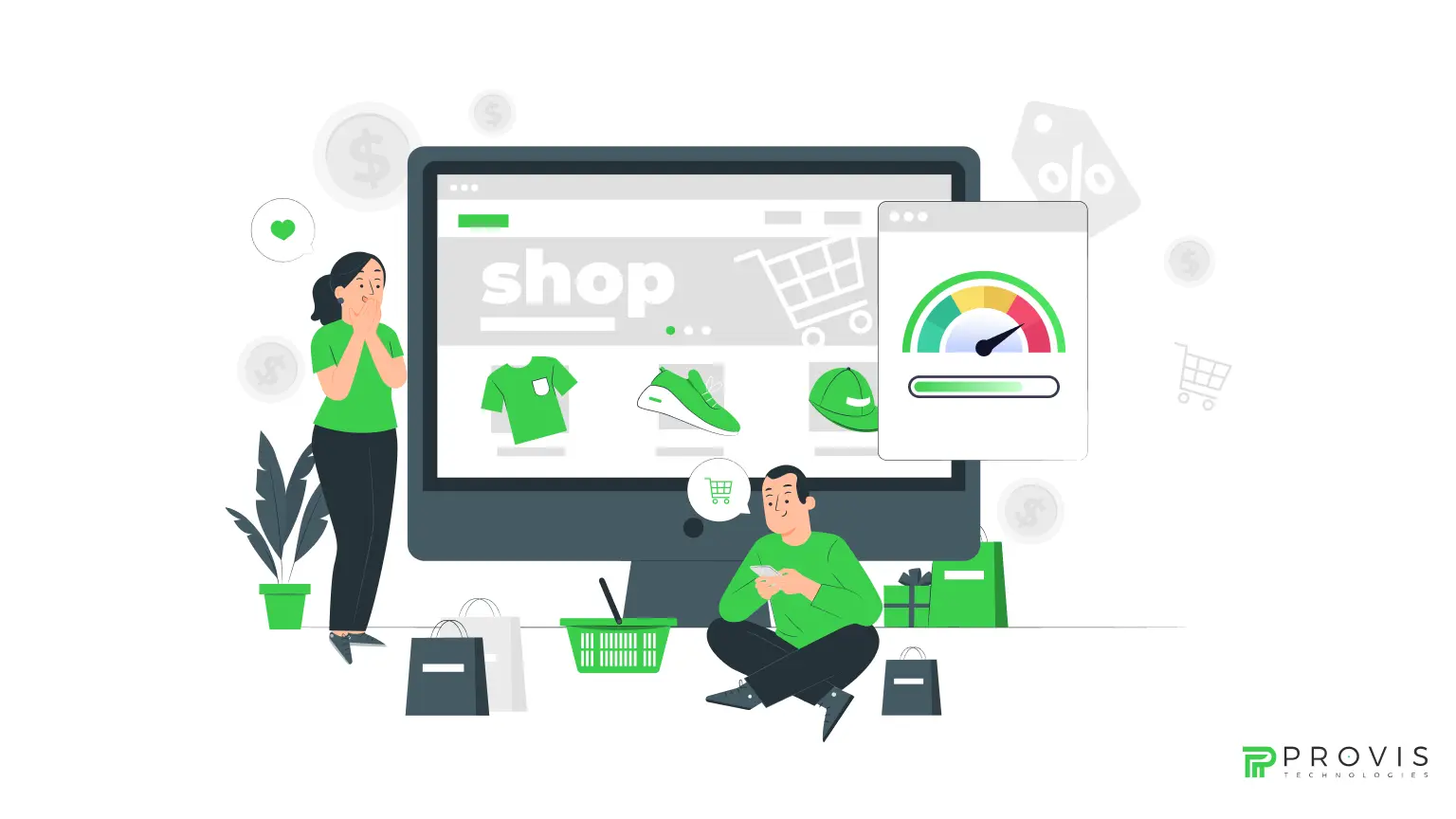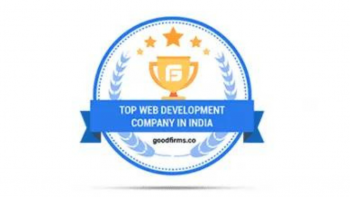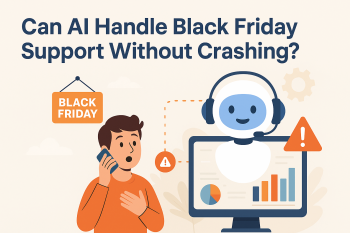ECommerce shoppers and every online customer in present times demand instant satisfaction from their shopping experiences. The online shopping experience and business sales performance heavily depends on the eCommerce site speed which stands as one of the primary influencing elements. Many organizations fail to understand the importance of website speed although it directly impacts their business performance. The result? Website slowness makes customers leave their carts while selling revenue decreases and search engine positions drop.
This blog will examine the vital link between ecommerce site performance and its sales and practical methods for improving business performance.
Why eCommerce site Speed Matters ?
The Connection Between Speed and User Experience
Every eCommerce business depends on user experience as its main element. Moreover, eCommerce site speed affects customer satisfaction to the extent that visitors tend to abandon your site before viewing your products.
Mobile website visitors tend to leave sites when page loading reaches 3 seconds or longer. This is evident as 53% of users decide to leave if the loading time is higher. Therefore, the time it takes for your site to load determines how many customers you will lose during that session.
The process takes a toll on both customer conversion and customer loyalty maintenance. As a result, the speed of website loading produces improved user experience that fosters both customer loyalty and continuous site visits.
Impact on Conversion Rates
The time required to load each page directly results in major conversion reduction for every passing second. Page load delay of only 1 second leads to sales loss from the daily revenue of $1.6 billion annually according to Amazon’s data.
The vast number proves without question that eCommerce site speed plays an essential role in converting users into customers.
Research indicates that website delays each second below acceptable standards results in a conversion rate decline of approximately 7%. Your earnings would experience a moderate bottom-line impact even though this initial effect may seem minimal at first.
SEO Ranking: Faster Sites Rank Higher

Mobile-first indexing entered the Google search engine landscape when Google introduced this system in 2018 making mobile websites the main source for search engine ranking.
The slower internet of mobile users has compelled Google to prioritize site speed evaluations more than before.
Core Web Vitals from Google measure eCommerce site speed as well as user experience through three factors that include page loading speed, interactive features and visual stability.
Search engines might lower your website placement in search results when it takes too long to load your pages thus it becomes harder for customers to discover your store.
How Slow Website Speed Affects Your eCommerce Sales
Cart Abandonment
The duration it takes pages to load serves directly as the main reason why customers tend to abandon their shopping carts. Potential buyers tend to leave their purchase uncompleted because they get frustrated by excessive load times on your product pages and checkout stages and shopping cart.
According to research from Baymard Institute, 69.57% of online shoppers stop their checkout process because of poor checkout procedures or lengthy slow-downs. The current speed of your website directly affects conversion rates so faster page loading produces higher sales numbers.
Increased Bounce Rates
Your site has a high bounce rate if visitors quickly depart because they refuse to stand by during prolonged page loading times. Your customers may leave the site between the time it takes for a page to load because slow pages fail to capture their attention.
Your site’s SEO ranking suffers from high bounce rates. Thus, it lowers your page visibility and the number of potential customers. Your SEO performance and conversion rates will advance when you lower your bounce rate through eCommerce site speed optimization.
How to Fix Your eCommerce Site Speed and Boost Sales
An understanding of eCommerce site speed importance brings us to examine solutions that will help fix it. These practical recommendations will enable you to enhance your page speed ecommerce, which results in better experiences for users and greater sales potential.
1. Optimize Images and Visual Content
Graphics and visuals of large dimensions represent the foremost factor contributing to website speed decay. Your site runs slower due to unoptimized product images together with banners and other visual contents.
How to Fix It:
- You should use TinyPNG as well as ImageOptim to minimize file size in images while maintaining outstanding image quality.
- Websites should use WebP and JPEG 2000 image formats since these compression techniques outperform traditional PNG and JPEG visual content.
- Your website loading speed would improve if you activate a system which allows assets to appear only when users scroll their page.
2. Leverage Browser Caching
Browser caching enables your website visitors to store specific webpage elements on their local devices allowing them to restrain from retrieving full page data upon each website visit. The time customers need to wait before website content loads will decrease dramatically because of this approach.
How to Fix It:
- Assign specific expiration times to photos, JavaScript files and stylesheet files. The distribution of resources through this method results in single downloads by browsers.
- Users can control caching through directives from the Cache-Control HTTP header.
3. Minimize HTTP Requests
All elements on your page that include images scripts or stylesheets trigger HTTP requests against the server which slows down page loading. Your page speed can improve after a reduction in the quantity of these requests.
How to Fix It:
- You should merge your CSS files and JavaScript files into single consolidated documents to lower your HTTP requests count.
- Users will experience better performance by eliminating all plugins scripts and resources which offer no benefit to page functionality.
4. Use a Content Delivery Network (CDN)
A CDN distributes multiple copies of your website throughout different server locations across the world. Your site visitors will receive content from the nearest CDN server during site visits because of this arrangement. As a result, this type of eCommerce website performance minimizes latency and improves page loading speed.
How to Fix It:
- Your users should get faster content delivery through a dependable CDN solution from Cloudflare or AWS CloudFront no matter their location.
5. Optimize Your eCommerce Platform
Each eCommerce platform demonstrates different speeds in performance operations. The platform you use might result in slowness because it fails to provide optimal performance.
How to Fix It:
- Your platform and its plugins should receive regular version updates because they commonly bring improved performance features.
- Older eCommerce platforms should be replaced with speed-enhanced solutions such as WooCommerce, Shopify, and Magento because these platforms come with native optimization capabilities.
6. Reduce Redirects and Broken Links
The page load times become slower when redirects (such as 301 redirects) along with broken links appear and this results in degraded user experience.
How to Fix It:
- Check your website for extra redirects through auditing then remove all redundant ones.
- A combination of Screaming Frog SEO Spider and Google Search Console tools enables users to locate broken links for prompt resolution.
7. Improve Mobile Performance
Online shopping through mobile devices becomes increasingly popular which requires optimistic website optimization for mobile platforms. Mobile users demand quick loading times since any delays from slow mobile performance will result in customer departure.
How to Fix It:
- Your platform needs responsive design functions to adjust to various display dimensions.
- Users need quick-loading mobile features such as touch buttons and images which must be optimized for mobile device performance.
The Final Thoughts for ecommerce site speed improvisation
Slow website performance leads people to leave your site. Thus, it decreases conversion rates and does harm to your SEO standing. Therefore, optimizing ecommerce website speed leads to better user satisfaction, store revenue and higher search engine placement.
Your eCommerce business success is dependent on implementing the specified speed optimization methods at once and watching your enterprise growth.
FAQs
1. How fast should my eCommerce site speed or loading speed should be?
An eCommerce website must load within three seconds to avoid user departures from its pages.
2. Does Google penalize slow websites?
Your website page speed plays a role in Google rankings while pages that display slow speed receive lower placement in search engine results.
3. How can I test my website speed?
Your website speed performance can be analyzed using Google PageSpeed Insights, GTmetrix and Pingdom which will provide practical suggestions for optimization.
Written By
Author's Picks
- WooCommerce Pros and Cons: An In-Depth Analysis
- 18/12/2024
- Guide for Security Testing for Ecommerce Websites in 2025
- 01/05/2025
- Top Customer Service Software Platforms for E-commerce Success
- 21/01/2025
Categories
- AI for Startups
- AI in Web Development
- AI Integration
- AI Platforms
- AI Prompt
- AI Tools
- AI Trading Software
- Android App
- Android vs iOS Development
- Angular
- API
- API Development
- App
- app development
- App Idea
- App User Feedback
- Application
- Artificial Intelligence
- Audit Services
- Automotive Industry
- Awards and Recognition
- Business Consulting
- Business Website
- Chatbots
- CRM
- CRM for Financial Advisors
- Custom CRM
- Custom SaaS
- Custom Website
- Customer Service
- dashboard design
- Developing a Mobile App
- Digital Business
- E-commerce
- EMR Integration
- Finance
- Financial Advisors
- Financial Advisors
- GIT
- Health Insurance
- iOS App
- iOS App Development
- IoT Mobile App Development
- IoT Platforms
- IT Audit Services
- IT Consulting
- IT Strategies
- Java Development
- Laravel
- Lean Canvas
- Learning Management System
- Logistics Apps
- Mobile App Development
- MVP
- Native App
- News Aggregator Site
- OTT
- Outsourcing IT
- Payment Gateway
- predictive analysis
- Product Launch Strategy
- Progressive Web App (PWA)
- Prototype
- Recommender Systems
- Ruby
- SaaS
- SaaS Application
- SaaS Business
- SaaS Company
- SaaS Development
- SaaS Product
- SaaS Project
- Sales Funnel
- SEO
- Shopping Cart
- Software Development
- SSL and TLS
- Startup Checklist
- Technology
- Tetradic Color Scheme
- UI/UX Design Company
- Unit Testing
- User Flow
- User Testing
- Web Development
- Web Performance Optimization
- website Maintenance Services
- Website Migration Service
- Website Speed Optimization
- WooCommerce
- WordPress





